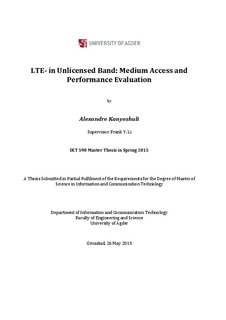| dc.description.abstract | Long Term Evolution (LTE) technology is challenged by high data rate demanding services and
increasing number of mobile phones which are equipped with Wi-Fi access capability. To respond to
this challenge, 3rd Generation Partnership Project (3GPP) initiated a Study Item (SI) which investigates
the co-existence of Wi-Fi and LTE technologies in the same unlicensed 5 GHz band. Given that Wi-Fi and
LTE are originally designed to operate in totally different bands, unlicensed and licensed, it is difficult to
achieve this coexistence for these two incompatible access technologies. Accordingly, 3GPP introduces
the Listen Before Talk (LBT) mechanism to ensure the coexistence feasibility of both two access
technologies in that band. This SI consists of License Assisted Access (LAA)-based LBT including Load
Based Equipment (LBE) and Frame Based Equipment (FBE) mechanisms which may be designed to
compete with Wi-Fi-based access mechanism towards a fair access on the shared channel.
In this thesis, we evaluate the performance of two newly proposed 3GPP medium access control (MAC)
and Wi-Fi-based mechanisms under diverse scenarios with different parameter configurations. The
evaluation is carried out through simulations and the considered performance parameters are Jain’s
fairness index (FI) and access opportunities obtained after multi-competitions on the shared channel.
Furthermore, we propose two MAC mechanisms referred to as enhanced LBE (E-LBE) and enhanced
FBE (E-FBE) and then evaluate and compare their performance with 3GPP MAC mechanisms.
Through extensive Matlab-based simulations, we observe that 3GPP mechanisms do not function well
since, depending on scenario, some of them get higher opportunities while others are starved, leading to
poor performance in terms of FI. At the same time, we observe that the performance of the proposed ELBE
mechanism varies, depending on the selected scenarios. On the other hand, the performance of the
proposed E-FBE access mechanism increases the FI up to 47%, achieving an average FI of 97%. This
result demonstrates that fair access and effective coexistence between MAC mechanisms are achieved
by employing E-FBE. Correspondingly, end users can get benefits from the coexistence of LTE and Wi-Fi
with fair access and equal opportunities. | nb_NO |
